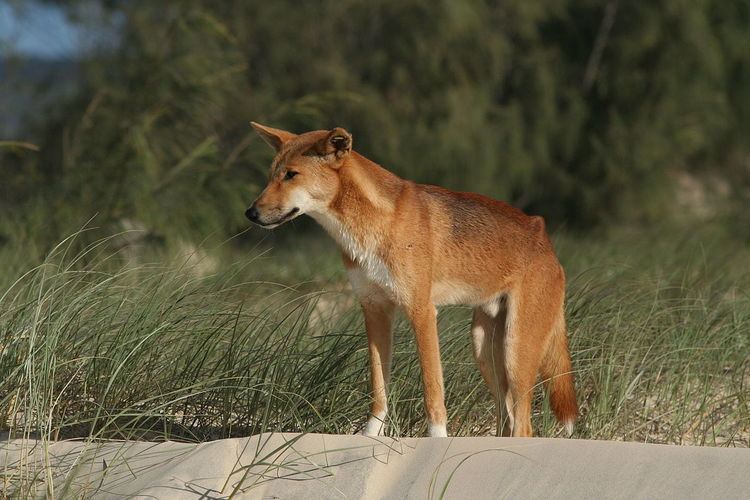 | ||
Dingo attacks on humans are rare but are known to happen. Dingoes are a danger to livestock, especially sheep and young cattle. The 5,614 kilometre Dingo Fence was constructed in Southeast Australia to protect the livestock there from attacks.
Contents
Wild dogs are fairly large predators, but are much smaller than able-bodied adults and therefore not generally much of a threat to them. However, they can be a serious threat to incapacitated, isolated, outnumbered, or very small humans, especially infants and young children.
Humans and dingoes generally tend to avoid each other. In some situations, however, such as on Fraser Island and some locations in the Northern Territory, close interaction between dingoes and humans, especially feeding dingoes, has led to dangerous habituation and attacks.
Dingo attacks on livestock, however, are fairly common occurrences and a serious concern for the Australian livestock industry.
Cause
The likelihood of wild dog attacks on humans depends to a large degree on how humans behave toward them. The more frequently these dogs are fed or scavenge human leftovers, the more likely it is that they lose all caution and sometimes react aggressively towards humans when they perceive themselves to be in conflict with the human over food.
During a study on Fraser Island dingoes, the researchers reasoned that the presence of humans influences the activity of dingoes. The tourism industry on the island encouraged people to approach dingoes without caution, and such encounters were practically expected by the tourists. People lost their caution when dealing with dingoes more and more frequently, and the number of reported interactions increased. The way the dingoes reacted towards humans was dependent on the way humans behaved toward them. Dingoes tended to show aggressive behaviour when humans fled, and tended to be intimidated when humans consciously or aggressively moved towards them. Humans making submissive postures seemed to cause a neutral or submissive reaction of the dingoes. That dingoes showed aggressive behaviour towards humans seemed to be similarly likely during different times of the year. However, adult dingoes might be more dangerous during the breeding season, and female dingoes especially when they raise their pups.
Even when habituation to humans seems to be the cause for attacks, it is not clear what the ultimate cause for attacks and overall threat towards humans is. It is possible that some attacks result from the "play" of young pups, especially with children. Attacks can also be caused by false reactions of humans to aggressive and dominance behaviour of dingoes. It is assumed that dingoes might have started to regard "human" food sources (garbage cans, leftovers, handouts, etc.) as part of their territory and that attacks on humans can therefore occur because the dingoes see humans as competitors and want to protect their food sources. That some dingoes might regard humans as prey was also deemed possible because humans, especially children, could be theoretically overpowered.
Cases
In December 1933, when three girls went missing near Mount Coot-tha, the possibility of their having been attacked by dingoes was considered. Local livestock men who live and work among dingoes all their lives, said that they had no direct knowledge of any dingo attacks on humans, but from what they knew of the animal, they reasoned that a dingo would attack a human if starving and the human defenseless. Some had heard of human remains found scattered by dingoes. Scholarly experts couldn't comment due to contradictory evidence.
The first well-documented case of a dingo attack on Fraser Island is from 1988. As early as 60 years before, a newspaper account reported of problems with dingoes. Between 1996 and 2001, 279 incidents with dingoes were reported, of which 39 were assessed as "major" and one as "catastrophic".
Three reports of dingo attacks on humans caused special attention:
Reactions
To be better prepared for dingo attacks demands were made that a better recording of problematic cases should be implemented. Also non-lethal guns, spray cans with appropriate content, whips and aversive baits should be used to increase the caution of the dingoes. "Problem-dingoes" should be killed, since relocation attempts proved to be ineffective.
The behaviour of humans might undermine these efforts; therefore the change of human behaviour is in the centre of attention. Warning signs like "Beware Dingoes" seem to have lost their effect on Fraser Island, despite their high numbers. Furthermore, some humans do not realise how adaptive and quick dingoes are. Therefore, they don't stay attentive enough and for instance don't consider that dingoes even steal food like fruits and vegetables. In addition some tourists seemed to be confused by the high numbers of rules in some parks and in some cases have been observed to actively feed the wild animals.
Attacks on humans
Below is a partial list of dingo attacks and alleged dingo attacks that occurred in Australia, in reverse chronological order.
Attacks on other animals
Dingos frequently prey on sheep, goats and cattle when they have the chance, which is why the Dingo Fence was built. Cattle are usually quite capable of defending themselves against dog attacks and the losses for cattle owners are therefore usually low, but sheep are extremely vulnerable and their behaviour in the presence of a predator can often lead to surplus killing. Some notable dingo attacks on animals which have appeared in reliable sources:
